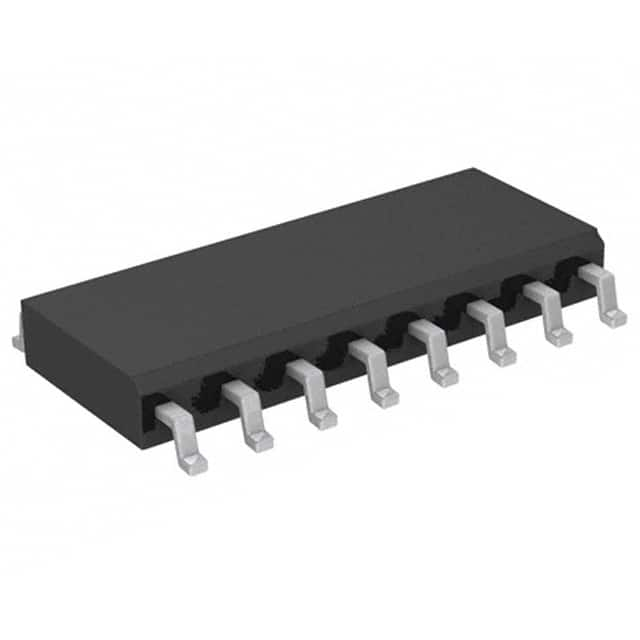74HC158D,652
Product Overview
Category
The 74HC158D,652 belongs to the category of integrated circuits (ICs).
Use
This IC is commonly used for data multiplexing and demultiplexing applications.
Characteristics
- High-speed operation
- Low power consumption
- Wide operating voltage range
- Compatibility with TTL levels
- Schmitt-trigger action on all inputs
Package
The 74HC158D,652 is available in a small outline package (SOIC) with 16 pins.
Essence
The essence of this product lies in its ability to efficiently multiplex and demultiplex data signals.
Packaging/Quantity
The 74HC158D,652 is typically packaged in reels or tubes, with a quantity of 2500 units per reel or 50 units per tube.
Specifications
- Supply Voltage: 2V to 6V
- Input Voltage: -0.5V to VCC + 0.5V
- Output Voltage: -0.5V to VCC + 0.5V
- Operating Temperature Range: -40°C to +125°C
- Propagation Delay: 10 ns (typical)
- Maximum Quiescent Current: 4 µA
Detailed Pin Configuration
The 74HC158D,652 has the following pin configuration:
- A1 - Data Input A
- B1 - Data Input B
- C1 - Data Input C
- D1 - Data Input D
- GND - Ground
- Y1 - Multiplexed Output Y
- E1 - Enable Input E
- Y2 - Multiplexed Output Y
- D2 - Data Input D
- C2 - Data Input C
- B2 - Data Input B
- A2 - Data Input A
- VCC - Supply Voltage
Functional Features
The 74HC158D,652 offers the following functional features:
- 4-bit data multiplexing and demultiplexing
- Independent enable input for each multiplexer
- Schmitt-trigger action on all inputs for improved noise immunity
- High-speed operation for efficient data processing
Advantages and Disadvantages
Advantages
- High-speed operation allows for quick data processing.
- Low power consumption makes it suitable for battery-powered devices.
- Wide operating voltage range provides flexibility in various applications.
- Compatibility with TTL levels ensures easy integration with existing systems.
- Schmitt-trigger action on all inputs enhances noise immunity.
Disadvantages
- Limited number of data inputs and outputs restricts its application scope.
- Lack of built-in protection features may require additional circuitry for robustness.
Working Principles
The 74HC158D,652 operates based on the principles of multiplexing and demultiplexing. It takes multiple data inputs and selects one output based on the control signals provided. The enable inputs allow independent control of each multiplexer, enabling selective data routing. The Schmitt-trigger action on all inputs helps to eliminate noise and ensure reliable signal processing.
Detailed Application Field Plans
The 74HC158D,652 finds applications in various fields, including:
- Communication Systems: Used for data multiplexing/demultiplexing in telecommunication networks.
- Industrial Automation: Enables efficient data routing in control systems.
- Consumer Electronics: Utilized in audio/video equipment for signal selection.
- Automotive Electronics: Facilitates data routing in automotive control units.
- Computer Peripherals: Enables efficient data transfer between devices.
Detailed and Complete Alternative Models
Some alternative models that offer similar functionality to the 74HC158D,652 include:
- SN74HC158D - Manufactured by Texas Instruments
- CD74HC158E - Manufactured by Texas Instruments
- MC74HC158N - Manufactured by ON Semiconductor
- 74HCT158 - Manufactured by NXP Semiconductors
These alternative models can be considered based on specific requirements and availability.
Word count: 529 words
기술 솔루션에 74HC158D,652 적용과 관련된 10가지 일반적인 질문과 답변을 나열하세요.
Sure! Here are 10 common questions and answers related to the application of 74HC158D,652 in technical solutions:
Q: What is the 74HC158D,652? A: The 74HC158D,652 is a quad 2-input multiplexer IC (Integrated Circuit) that can be used for data selection and routing in digital circuits.
Q: What is the operating voltage range of the 74HC158D,652? A: The 74HC158D,652 operates within a voltage range of 2V to 6V.
Q: How many inputs does the 74HC158D,652 have? A: The 74HC158D,652 has four inputs labeled A, B, C, and D.
Q: How many output channels does the 74HC158D,652 have? A: The 74HC158D,652 has two output channels, Y0 and Y1.
Q: Can the 74HC158D,652 handle analog signals? A: No, the 74HC158D,652 is designed to work with digital signals only.
Q: What is the maximum frequency at which the 74HC158D,652 can operate? A: The 74HC158D,652 can operate at a maximum frequency of 50 MHz.
Q: How can I select the desired input on the 74HC158D,652? A: The input selection is controlled by the combination of control inputs, such as the E (Enable) and S0/S1 (Select) pins.
Q: Can I cascade multiple 74HC158D,652 ICs together? A: Yes, you can cascade multiple 74HC158D,652 ICs to increase the number of input channels.
Q: What is the output voltage level of the 74HC158D,652? A: The output voltage level of the 74HC158D,652 is compatible with standard CMOS logic levels.
Q: Can I use the 74HC158D,652 in both digital and analog multiplexing applications? A: No, the 74HC158D,652 is specifically designed for digital multiplexing applications and may not be suitable for analog signals.
Please note that these answers are general and may vary depending on specific circuit requirements and datasheet specifications.


